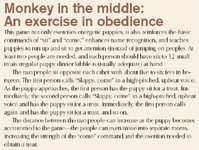Counseling new puppy owners: Normal play vs. aggressive tendencies
Many owners begin their relationship with new puppies armed with misinformation and an idealistic view of the pet-owner relationship. Owners often don't know how to properly shape behaviors or handle problems, and one area that needs special attention is play aggression.
Many owners begin their relationship with new puppies armed with misinformation and an idealistic view of the pet-owner relationship. Owners often don't know how to properly shape behaviors or handle problems, and one area that needs special attention is play aggression.

PUPPIES CAN PLAY ROUGH
Most puppy play consists of chasing, pouncing, barking, growling, snapping, and biting. So how can new owners tell the difference between normal play and possible signs of true aggression in puppies?
In normal play, a puppy may play bow (lower its head and raise its hind end), present its front end or side to the owner, hold the front part of its body up, wag its tail, dart back and forth, emit high-pitched barks and growls, and spontaneously attack. Of course, even normal play can become too intense.
Behaviors that may indicate a problem are prolonged, deep-tone growling; a fixed gaze; a stiff posture; and aggression that is situational or stimulus-dependent (not spontaneous). These aggressive behaviors may be related to fear, possessiveness, conflict, or pain and necessitate immediate evaluation by you or a behavior expert.
PLAY BEHAVIOR INTERVENTION
Puppies must learn how to play appropriately, so suggest these forms of intervention for your clients.
- Distract the bad behavior. Always have a toy on hand that the puppy can transfer its attention to.
- Speak up and step out. If the puppy is biting hard, yell "Ouch!" and stop playing.
- Interrupt problem behaviors. A shake can, a water gun, or compressed air will startle puppies and stop the behavior. But don't use these techniques if a pet has a sensitive temperament or if the techniques seem to make things worse.
- Set up a dragline. Both indoors and outdoors, make sure the puppy is on a leash that you can quickly grab to stop the behavior.
- Use head halters. These halters provide a more natural sense of control than ordinary collars do and limit the chances of biting.
- Consider muzzles. In extreme cases, muzzles may be used for short periods to prevent biting.
- Give the puppy a time out. If the puppy won't stop the bad behavior, put the puppy in a room or in its kennel with toys to keep it busy until it calms down.

Monkey in the middle: An exercise in obedience
PREVENT INAPPROPRIATE PLAY
In addition, offering owners these tips on interacting with, socializing, and training their puppies may help prevent abnormal play aggression.
- Provide plenty of exercise. Puppies are bundles of energy, so give them productive ways to expend that energy, such as going on walks or playing "Monkey in the middle" (see sidebar).
- Provide mental stimulation. Rubber toys that can be filled with treats, such as Kong toys or Busy Buddy puzzle toys (Premier), offer puppies a chance to chase and bite the toys and obtain a food reward.
- Play with your pup. Playing fetch or throwing a soccer ball for the puppy to push around saps some of its energy.
- Teach and review basic obedience commands. A well-trained dog is more likely to follow orders when behaving inappropriately.
- Conduct leadership exercises. Follow these rules to maintain overall order: 1) Nothing in life is free. Ask the pet to respond to a command such as "sit" before the pet receives anything it wants or needs. 2) Don't tell me what to do. Do not allow the pet to be pushy about soliciting attention from you. Pull your hands in, lean away, and look away from the pet if it nudges, whines, barks, leans, or pushes for attention. Walk away if the pet is too difficult to ignore. Once the pet stops soliciting attention for 10 seconds, ask the pet to sit and give it attention. 3) Don't move without permission. Anytime you begin to move from one area of the home to another, ask the pet to sit and stay for a second or two before you give a release command to follow you.
- Don't sit on the floor with the pup. This tends to get puppies excited, puts family members in a vulnerable position, and makes it more difficult to control the pet.
- Promote socialization. Puppies must have frequent, positive social experiences with all types of animals and people during the first three or four months of life to prevent asocial behavior, fear, and biting. And continued exposure to a variety of people and animals as the pets grow is essential for maintaining good social skills.
WHAT NOT TO DO
Be sure that the family is not using any physically punitive methods such as scruff shakes, alpha rollovers, squeezing the pet to the floor, thumping the nose, or swatting.
PROVIDE BEHAVIOR ADVICE WITHOUT DELAY
Whatever you do in the way of counseling new pet owners, remember that providing behavior information from the outset can make a big difference in the relationship between the pet and the owner. Owners need reliable help to weed out conflicting and inappropriate training information, and behavior problems are much easier to prevent than to correct.
Everybody wins when we take the time and effort to provide timely behavior counseling. The owner is more likely to have a well-behaved pet, we are more likely to have a manageable patient, and the pet is more likely to remain an important part of the family.
Wayne L. Hunthausen, DVM, Animal Behavior Consultations, 4820 Rainbow Blvd. Westwood, KS 66205.
Veterinary scene down under: IV fluid shortage updates, and more news
September 3rd 2024Updates on the intravenous fluid shortage impacting Australian veterinary practices, a welcome funding boost for the Veterinary and Community Care charity, and Australia’s first Fear Free Certified veterinary practice.
Read More